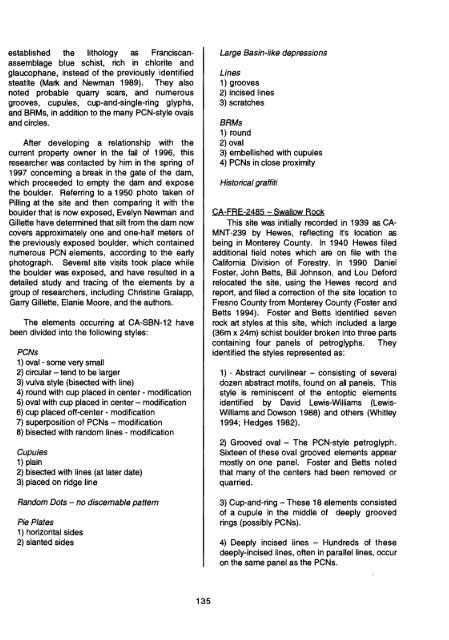a stylistic analysis of the rock art of ca-sbn-12 - Society for California ...
a stylistic analysis of the rock art of ca-sbn-12 - Society for California ...
a stylistic analysis of the rock art of ca-sbn-12 - Society for California ...
You also want an ePaper? Increase the reach of your titles
YUMPU automatically turns print PDFs into web optimized ePapers that Google loves.
established <strong>the</strong> lithology as Francis<strong>ca</strong>nassemblage<br />
blue schist, rich in chlorite and<br />
glaucophane, instead <strong>of</strong> <strong>the</strong> previously identified<br />
steatite (Mark and Newman 1989). They also<br />
noted probable quarry s<strong>ca</strong>rs, and numerous<br />
grooves, cupules, cup-and-single-ring glyphs,<br />
and BRMs, in addition to <strong>the</strong> many PCN-style ovals<br />
and circles.<br />
After developing a relationship with <strong>the</strong><br />
current property owner in <strong>the</strong> fall <strong>of</strong> 1996, this<br />
researcher was contacted by him in <strong>the</strong> spring <strong>of</strong><br />
1997 conceming a break in <strong>the</strong> gate <strong>of</strong> <strong>the</strong> dam.<br />
which proceeded to empty <strong>the</strong> dam and expose<br />
<strong>the</strong> boulder. Referring to a 1950 photo taken <strong>of</strong><br />
Pilling at <strong>the</strong> site and <strong>the</strong>n comparing it with <strong>the</strong><br />
boulder that is now exposed, Evelyn Newman and<br />
Gillette have determined that silt from <strong>the</strong> dam now<br />
covers approximately one and one-half meters <strong>of</strong><br />
<strong>the</strong> previously exposed boulder, which contained<br />
numerous PCN elements, according to <strong>the</strong> early<br />
photograph. Several site visits took place while<br />
<strong>the</strong> boulder was exposed, and have resulted in a<br />
detailed study and tracing <strong>of</strong> <strong>the</strong> elements by a<br />
group <strong>of</strong> researchers, including Christine Gralapp,<br />
Garry Gillette, Elanie Moore, and <strong>the</strong> authors.<br />
The elements occurring at CA-SBN-<strong>12</strong> have<br />
been divided into <strong>the</strong> following styles:<br />
PCNs<br />
1) oval - some very small<br />
2) circular - tend to be larger<br />
3) vulva style (bisected with line)<br />
4) round with cup placed in center - modifi<strong>ca</strong>tion<br />
5) oval with cup placed in center - modifi<strong>ca</strong>tion<br />
6) cup placed <strong>of</strong>f-center - modifi<strong>ca</strong>tion<br />
7) superposition <strong>of</strong> PCNs - modifi<strong>ca</strong>tion<br />
8) bisected with random lines - modifi<strong>ca</strong>tion<br />
Cupules<br />
1) plain<br />
2) bisected with lines (at later date)<br />
3) placed on ridge line<br />
Random Dots - no discemable pattern<br />
Pie Plates<br />
1) horizontal sides<br />
2) slanted sides<br />
Large Basin-like depressions<br />
Lines<br />
1) grooves <br />
2) incised lines <br />
3) scratches <br />
BRMs<br />
1) round <br />
2) oval <br />
3) embellished with cupules <br />
4) PCNs in close proximity <br />
Histori<strong>ca</strong>l graffiti<br />
CA-FRE-2485 - Swallow Rock<br />
This site was initially recorded in 1939 as CA<br />
MNT-239 by Hewes, reflecting irs lo<strong>ca</strong>tion as<br />
being in Monterey County. In 1940 Hewes filed<br />
additional field notes which are on file with <strong>the</strong><br />
Cali<strong>for</strong>nia Division <strong>of</strong> Forestry. In 1990 Daniel<br />
Foster, John Betts, Bill Johnson, and Lou De<strong>for</strong>d<br />
relo<strong>ca</strong>ted <strong>the</strong> site, using <strong>the</strong> Hewes record and<br />
report, and filed a correction <strong>of</strong> <strong>the</strong> site lo<strong>ca</strong>tion to<br />
Fresno County from Monterey County (Foster and<br />
Betts 1994). Foster and Betts identified seven<br />
<strong>rock</strong> <strong>art</strong> styles at this site, which included a large<br />
(36m x 24m) schist boulder broken into three p<strong>art</strong>s<br />
containing four panels <strong>of</strong> petroglyphs. They<br />
identified <strong>the</strong> styles represented as:<br />
1) - Abstract curvilinear - consisting <strong>of</strong> several<br />
dozen abstract motifs, found on all panels. This<br />
style is reminiscent <strong>of</strong> <strong>the</strong> entoptic elements<br />
identified by David Lewis-Williams (Lewis<br />
Williams and Dowson 1988) and o<strong>the</strong>rs (Whitley<br />
1994; Hedges 1982).<br />
2) Grooved oval - The PCN-style petroglyph.<br />
Sixteen <strong>of</strong> <strong>the</strong>se oval grooved elements appear<br />
mostly on one panel. Foster and Betts noted<br />
that many <strong>of</strong> <strong>the</strong> centers had been removed or<br />
quarried.<br />
3) Cup-and-ring - These 18 elements consisted<br />
<strong>of</strong> a cupule in <strong>the</strong> middle <strong>of</strong> deeply grooved<br />
rings (possibly PCNs).<br />
4) Deeply incised lines - Hundreds <strong>of</strong> <strong>the</strong>se<br />
deeply-incised lines, <strong>of</strong>ten in parallel lines, occur<br />
on <strong>the</strong> same panel as <strong>the</strong> PCNs.<br />
135
















